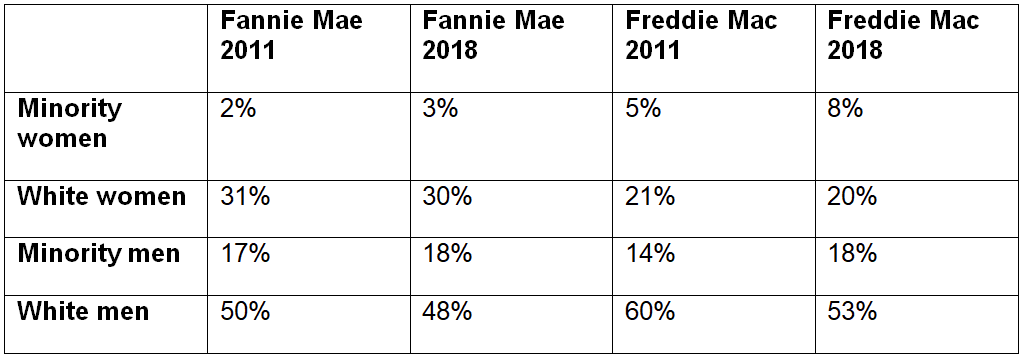The GSEs' management has become more diverse in the last decade – but top lawmakers say they're not doing enough

A government report shows that Fannie Mae and Freddie Mac have made insufficient progress when it comes to diversity and inclusion, top lawmakers say.
The Government Accountability Office (GAO) recently released a study on the GSEs’ efforts to promote diversity and inclusion and found that they had only slightly increased representation of women and minorities in leadership positions between 2011 and 2019.
“In 2019, the number of women on the boards of directors at Fannie Mae and Freddie Mac … were five and three, respectively, slightly higher than in 2011,” the GAO said in its report. “Female directors held leadership positions on the enterprises’ boards for the first time in 2019, serving as vice chair at Fannie Mae and chair at Freddie Mac. The percentage of women in senior management positions remained relatively consistent between 2011 and 2018, while minority representation was higher in 2018 than in 2011.”
Percentage of women and minorities in management roles at Fannie and Freddie

Source: Government Accountability Office
The GAO also found that Fannie and Freddie used diverse broker-dealers (such as minority- and women-owned firms) “to a limited extent.”
“In 2019, Fannie Mae and Freddie Mac both paid about 6 percent of their financial transaction fees to diverse broker-dealers,” the report said. “The enterprises have taken steps to work with diverse broker-dealers more often, such as by lowering some capital requirements to allow participation by typically smaller, less-capitalized diverse broker-dealers.”
The GAO said that broker representatives it had interviewed said that the GSEs had taken steps to increase their participation.
“However, some representatives noted that additional performance feedback and data on how they compare to larger firms would help them understand what business areas they could improve to meet standards for handling additional, more complex products.”
Despite the improvements noted by the GAO, however, top Democrats said Fannie and Freddie need to do more.
“This GAO report demonstrates that despite efforts to increase diversity, there has been a troubling lack of growth in diversity and inclusion at Fannie and Freddie,” said Rep. Maxine Waters (D-Calif.) chairwoman of the House Financial Services Committee. “According to the report, the percentage of women of color in management roles at both Fannie and Freddie has remained in the single digits from 2011 to 2019. The GSEs can and must do better.”
Waters said that she was also concerned that the GAO failed to make any recommendations in its report as to how the Federal Housing Finance Agency could hold the GSEs accountable for achieving more diversity.
“Study after study has proven that companies that are more diverse and inclusive are more profitable and perform better financially,” said Rep. Joyce Beatty (D-Ohio). “It is in the interest of the American people that the GSEs lead the industry in diversity and inclusion to help bolster their bottom line and ensure they never need another taxpayer-funded bailout.”
“This GAO report shows that Fannie Mae and Freddie Mac have made insufficient progress in diversifying their boards, workforce, and use of broker-dealers,” said Rep. Carolyn B. Maloney (D-N.Y.). “The two GSEs were responsible for more than 60% of US residential mortgages outstanding in 2019, and the report makes clear that they need to improve their diversity and inclusion efforts to better reflect and understand the customers they serve.”
Maloney also noted that the report found that while the share of women in management roles at both GSEs increased slightly between 2011 and 2018, the share of all female employees actually declined.
“It is key for the GSEs to recruit more women in these lower-level positions, as they are better positioned to be promoted and considered for future senior management positions, like board membership,” she said. “As I’ve stated before, improving board diversity is good governance, good business, and good policy, but promoting diversity and inclusion requires a holistic approach – from the highest levels of management to lower-level employees.”



